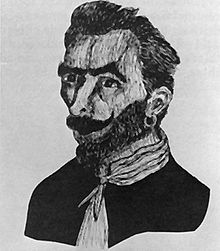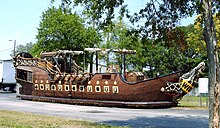José Gaspar
From Wikipedia, the free encyclopedia
(Redirected from Jose Gaspar)
José Gaspar, known by his nickname Gasparilla (supposedly lived c. 1756 – 1821), was a purported Spanish pirate, the "last of the Buccaneers," who is claimed to have raided the west coast of Florida during the late 18th and early 19th centuries. Though he is a popular figure in Florida folklore, no evidence of his existence appears in writing before the early 20th century. His legend is celebrated every year in Tampa with the Gasparilla Pirate Festival.
Contents
[hide]Legend[edit]
The stories of Gaspar are fairly consistent. Most say he was born in Spain in 1756 and served in the Spanish Navy aboard the Floridablanca. Among his early exploits was his kidnapping of a young girl for ransom; some versions give his subsequent capture as the impetus for joining the navy. Simpler versions of the story have him starting a mutiny and becoming a pirate soon after, but more romantic ones say he achieved a high rank and became a councillor to King Charles III. He was popular in the court, but when he spurned one lover for another, the jilted lady levied false charges against him, often said to involve the theft of thecrown jewels. To escape arrest he commandeered his ship and vowed to exact revenge on his country through piracy. Renaming himself "Gasparilla", he patrolled the coast of Spanish Florida for the next 38 years (often 1783 – 1821, approximately the dates of the second Spanish rule of Florida), sacking every passing ship and amassing a huge treasure, which was stored in his fabulous den on Gasparilla Island. Most male prisoners would be put to death or recruited as pirates, while women would be taken to a nearby isle, called Captiva Island for this reason, where they would serve as concubines or await ransom payment from their families.
This is one of several Gasparilla tales that attempt to explain a local place name. One of the most famous involves a Spanish (or Mexican) princess Gaspar had captured. Allegedly named Useppa, she consistently rejected the pirate's advances until he threatened to behead her if she would not submit to his lust. Still she refused, and he killed her in a rage (or alternately because his crew demanded her death). The captain instantly regretted the deed and took her body to a nearby island, which he named Useppa in her honor, and buried her himself. Some versions identify the lady with Josefa de Mayorga, daughter of Martín de Mayorga, viceroy of New Spain from 1779 to 1782, and contend that the island's name evolved over time. Similarly, Sanibel Island is said to have been named by Gaspar's first mate, Roderigo Lopez, after his lover whom he had left back in Spain. Empathizing with his friend's plight, Gaspar eventually allowed Lopez to return home, and even trusted him with his personal log. Sanibel Island re-emerges in other stories as the headquarters of Black Caesar, a Haitian pirate whose story has become entangled with Gasparilla's.
Then in 1821, the year Spain sold the Florida Territory to the United States, Gasparilla decided to retire. But while the men were going about dividing up the treasure, they spotted a fat British merchant ship, an opportunity too good to pass up. But when they approached, the intended victims lowered the Union Jack and raised an American flag, revealing that this was no merchant vessel, but the pirate hunting schoonerUSS Enterprise. In the battle that followed, Gasparilla's ship was riddled by cannonballs. Rather than surrender, Gaspar chained the anchor around his waist and leapt from the bow, shouting "Gasparilla dies by his own hand, not the enemy's!" Most of the remaining pirates were killed or captured and subsequently hanged, but a few escaped, one of them being Juan Gómez, who would tell the tale to subsequent generations. Gómez
Sources of the legend[edit]
Railroad Brochure[edit]
The first written account of José Gaspar comes from a 1900 advertising brochure for the Charlotte Harbor and Northern Railroad Company, a part of Henry B. Plant's railroad system that ran to Plant's Boca Grande Hotel on Gasparilla Island in Charlotte Harbor. The brochure related the legend of Gaspar and claimed that the pirate's vast cache of buried treasure had been hidden on the island and had never been found.[1][2]
This brochure was used in advertising for the resort and and was freely distributed to guests. In 1923, a Boston historian named Francis B. C. Bradlee received a copy of the brochure and, assuming that the story was true, included Jose Gaspar in a book he was writing about piracy. His book, Piracy In The West Indes And Its Suppression, was used as a source for later works such as Philip Gosse's Pirates' Who's Who and Frederick W. Dau's Florida Old and New, the authors of which also took Gaspar's authenticity for granted. From this point on, historical works about pirates routinely included Gaspar / Gasparilla.
Juan Gómez[edit]
This Juan Gómez, or John Gómez, was a real person who lived in Southwest Florida in the 1800s. As an old man, Gómez (who spent his last years on Panther Key near Marco Island, Florida) was well known locally for his tall tales of his supposed life as a pirate, and was said to have been the oldest man in the US when he died in 1900 (though this is very unlikely). Although no pre-20th century accounts of Gómez specifically links his alleged piratical exploits to José Gaspar, versions of his stories were incorporated into the railroad brochure history of Gasparilla and other subsequent recounts, sometimes claiming that Gómez had been a member of the pirate's crew.[1][2]
"The Hand of Gasparilla"[edit]
In the 1930's, while working on the Cass Street Bridge reconstruction in downtown Tampa, railroad worker Ernesto Lopez is said to have discovered a box containing a pile of Spanish and Portugese colonial coins, a map indicating that the rest of Gaspar's treasure was hidden nearby, and a severed hand wearing a ring engraved with the name "Gaspar."
In 2015, these artifacts appeared on national news outlets after Lopez's great-grandchildren rediscovered the box in their late grandfather's attic. However, upon examination, experts at the Tampa Bay History Center determined that the coins were non-precious souvenir coins from a Gasparilla parade and the map was from no earlier than the 1920s, as several local landmarks built around that time are depicted. The origin of the hand remained a mystery, though the curator of the history center opined that it was a mummified monkey hand.[3]
Gasparilla Pirate Festival[edit]
Main article: Gasparilla Pirate Festival
In 1904, members of the Tampa business elite put on an "invasion" of their city based on the increasingly popular figure of Gasparilla. Under the guise of "Ye Mystic Krewe of Gasparilla", an organization modeled after the New Orleans Mardi Gras paradekrewes, the invaders donned pirate costumes and rode through the streets on horseback. The event was a hit, and the Krewe planned an even more elaborate spectacle the next year, when all 60 of Tampa's cars were paraded through downtown. The Gasparilla Pirate Festival has been celebrated almost every year since then, with only two lapses, and today, over 400,000 attend the event, which contributes over $20 million to the local economy.[4]
| |||




No comments:
Post a Comment